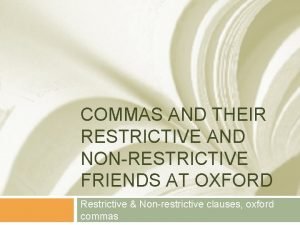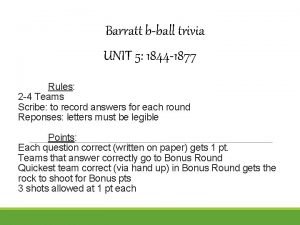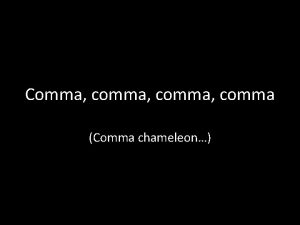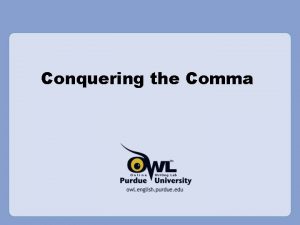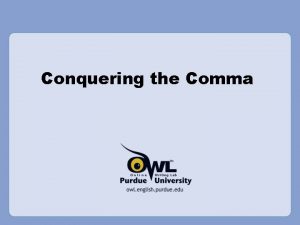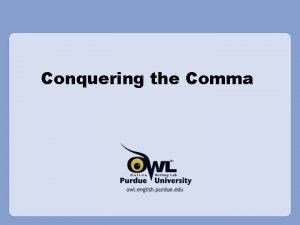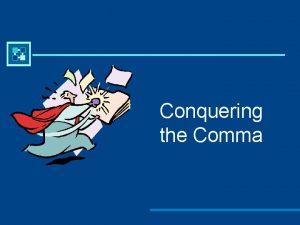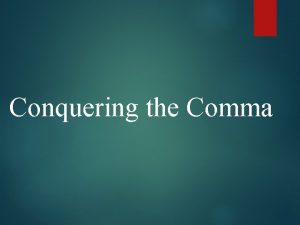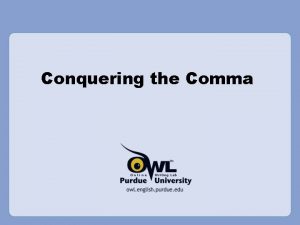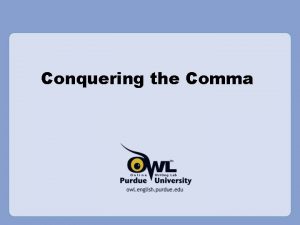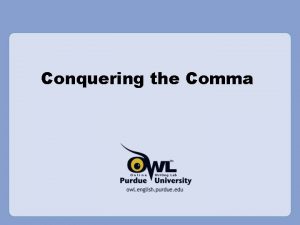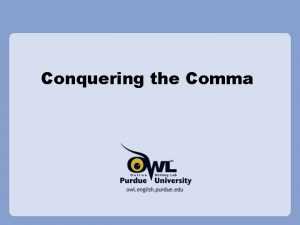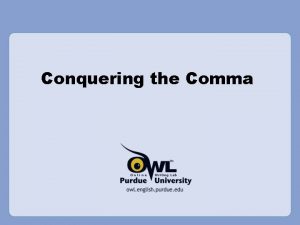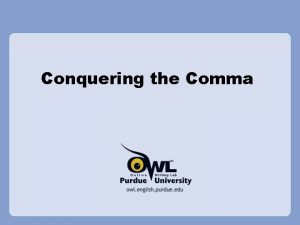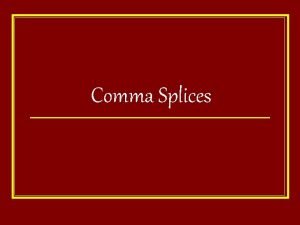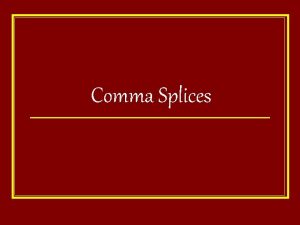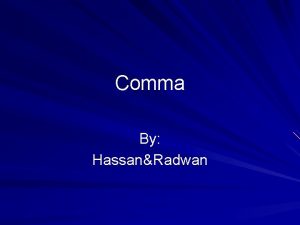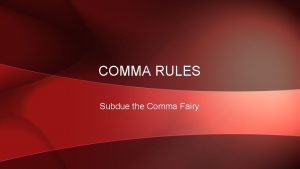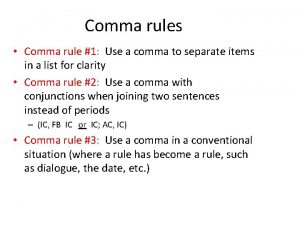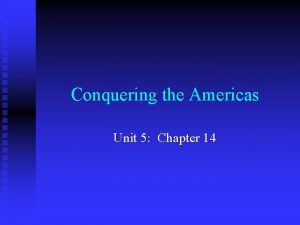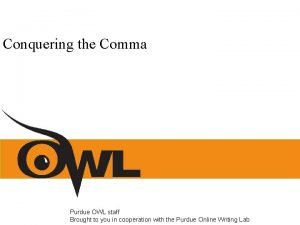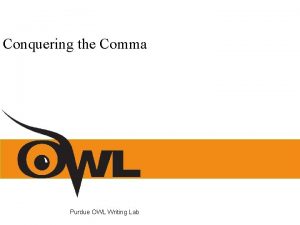Conquering the Comma What is a Comma A








































- Slides: 40

Conquering the Comma

What is a Comma? • A comma is a punctuation mark that indicates a pause is needed in a sentence. • Commas help to clarify meaning for the reader.






Clauses and Phrases • A clause is a group of words that contains both a subject and a verb that complement each other. • A phrase is a group of words that does not contain a subject or a verb that complement each other.

Sentence Structure: Introductory Clause • When the phrase or clause comes at the beginning of the sentence, the comma goes after the phrase or clause. phrase S V Before the test, Dan struggled with his Conj. S V homework, so his father helped him.

Introductory Words • Commas set off introductory words. – Well, wow, no, yes, maybe, etc. • Commas also set off a name when addressing a person. – Example: Nancy, will you please help me? – Example: I will do not that, Joe.

Introductory Clause • Where would you place the comma in the following example? S V Because it was raining we decided to go to the movies.

Introductory Clause • Where would you place the comma in the following example? Introductory clause S V Because it was raining, we decided to go to the movies.

Sentence Structure: Dependent Clause • A dependent clause contains a subject and verb, but the clause cannot stand independently. • Dependent clauses can often be identified by the use of dependent clause markers. • Some dependent clause markers: because though since although when unless while after until before if once as whether

Dependent Clause: at end of sentence When a dependent clause is At the end, Do Not place a comma between the two. S V We decided to go to the movies because we were bored.

Dependent Clause: at the beginning of a sentence When a dependent clause is at the beginning of a sentence, use a comma between the two clauses. S V If we decide to go to the movies, we will call you.

Dialogue • A comma is used before (or after) a quotation, as in dialogue. Ex) My brother yelled, “I’ll race you home. ” Ex) “Okay, ” I hollered back. Ex) “Well, ” she said hesitantly, “I guess I will go. ”

Essential and Non-essential Phrases and Clauses • An essential clause or phrase is used to modify a noun. • It also adds information that is critical to the meaning of the sentence. • Essential clauses are NOT set off by commas. S essential phrase V The people who work in my office are loud.

Sentence Structure: Essential Phrases and Clauses • The word “that” is almost always an indicator of an essential phrase or clause. S essential V The tiramisu that I had at Joe’s was great.

Sentence Structure: Nonessential Phrases & Clauses • A nonessential phrase or clause adds extra information to a sentence. • This information can be eliminated from the sentence without jeopardizing the meaning of the sentence. • Always place commas around nonessential phrases and clauses.

Sentence Structure: Nonessential Phrases & Clauses • Even without the phrase the sentence still makes sense: My brother plans to throw a party. S non-essential V My brother, who lives across town, plans to throw a party.

Sentence Structure: Nonessential Phrases & Clauses • Use commas to set off additional information. S V Steve said that he would propose to me on non-essential Valentine’s Day, which is my favorite holiday.

Comma Practice • Would you place commas in the following sentences? If so, where? I am planning a trip to Paris which is one of the greatest cities in the world. The place that I would most like to see is the Eiffel Tower. Pierre who is one of my business contacts will meet me at the airport.

Sentence Structure: Commas in a Series • Place commas in a sentence to divide items in a list. • The commas will help the reader to avoid confusion. • The comma before the conjunction is generally required, but it can be omitted if there is no possibility of confusion. – Random Fun Fact- it’s called an Oxford comma


Sentence Structure: Commas in a Series Consider the difference in the following: Last month, Alex dated Mary Ann Lee and Kim. Last month, Alex dated Mary, Ann, Lee, and Kim. Last month, Alex dated Mary Ann, Lee, and Kim. How many women did Alex date?

Sentence Structure: Commas in a Series • Commas should be placed in series of words, phrases, or clauses. • Place commas in the following sentences: Martina brushed her hair put on her pajamas and went to bed. She fell asleep and dreamed that she was a princess she kissed a frog and she rescued her prince.

Commas with Adjectives • Use commas to separate adjectives that provide an equal description of a noun. The Test: Can you put “and” between the adjectives? Can they be described in reverse order? If so, use a comma. big blue house | three hungry kittens | a cranky, bald man

Compound Sentence and comma splice • A sentence that contains two independent clauses joined by a coordinating conjunction is called a compound sentence. • A conjunction joins words, phrases, and clauses together in a sentence. • Conjunctions – – – – for and nor but or yet so FANBOYS

Sentence Structure: Compound Sentences • The comma in a compound sentence is placed before the coordinating conjunction. S V Conj. S V Andy built a snowman, and Jeff played with his dog.

Sentence Structure: Compound Sentence Where would you place the comma in the following sentence? S V S Dan struggled with his homework so his father V helped him.

A Common Error: The Comma Splice • A comma splice is an error in which two independent clauses are joined by a comma. S V Dan struggled with his homework, his S V father helped him.

To Correct a Comma Splice • Insert a conjunction between the two independent clauses. • Start a new sentence. • Insert a semi-colon between the two independent clauses (only in cases where the independent clauses are closely related in topic).

To Correct a Comma Splice S V Conj. Dan struggled with his homework, so his S V father helped him.

To Correct a Comma Splice S V Dan struggled with his homework. His S V father helped him.

To Correct a Comma Splice S V Dan struggled with his homework; his S V father helped him.

Comma Splice Practice • How would you correct the following? This semester I am taking calculus physics and economics. Calculus is my best subject, I am certain I will get an A. Although I am very busy, I still find time to have fun. Last weekend my brother visited me and we went to a football game a party and a rock concert.

Semicolons Use a semi-colon to separate independent clauses not joined by a conjunction. You cannot have a semi-colon AND a conjunction. Ex) My science class is third hour; it is my favorite class.

Semicolons Use a semicolon to separate independent clauses if they are joined by adverbs, such as however, also, besides, indeed, in fact, otherwise, furthermore, etc. Ex) We want to come to your party; however, Mary has a bad cold. Ex) We want to come to your party; Mary, however, has a bad cold.

Additional Help • • Purdue University Writing Lab Heavilon 226 Grammar Hotline: (765) 494 -3723 Check our web site: http: //owl. english. purdue. edu • Email brief questions: http: //owl. english. purdue. edu/writinglab/email/owlmail

The End
 Comma comma comma chameleon meme
Comma comma comma chameleon meme Forty niners apush
Forty niners apush Chúa yêu trần thế alleluia
Chúa yêu trần thế alleluia Hổ sinh sản vào mùa nào
Hổ sinh sản vào mùa nào Diễn thế sinh thái là
Diễn thế sinh thái là đại từ thay thế
đại từ thay thế Vẽ hình chiếu vuông góc của vật thể sau
Vẽ hình chiếu vuông góc của vật thể sau Công thức tính độ biến thiên đông lượng
Công thức tính độ biến thiên đông lượng 101012 bằng
101012 bằng Tỉ lệ cơ thể trẻ em
Tỉ lệ cơ thể trẻ em Thế nào là mạng điện lắp đặt kiểu nổi
Thế nào là mạng điện lắp đặt kiểu nổi Lời thề hippocrates
Lời thề hippocrates Vẽ hình chiếu đứng bằng cạnh của vật thể
Vẽ hình chiếu đứng bằng cạnh của vật thể Quá trình desamine hóa có thể tạo ra
Quá trình desamine hóa có thể tạo ra Môn thể thao bắt đầu bằng chữ đua
Môn thể thao bắt đầu bằng chữ đua Hát kết hợp bộ gõ cơ thể
Hát kết hợp bộ gõ cơ thể Khi nào hổ con có thể sống độc lập
Khi nào hổ con có thể sống độc lập Dot
Dot Biện pháp chống mỏi cơ
Biện pháp chống mỏi cơ độ dài liên kết
độ dài liên kết Trời xanh đây là của chúng ta thể thơ
Trời xanh đây là của chúng ta thể thơ Chó sói
Chó sói Thiếu nhi thế giới liên hoan
Thiếu nhi thế giới liên hoan điện thế nghỉ
điện thế nghỉ Fecboak
Fecboak Một số thể thơ truyền thống
Một số thể thơ truyền thống Thế nào là hệ số cao nhất
Thế nào là hệ số cao nhất Slidetodoc
Slidetodoc Sơ đồ cơ thể người
Sơ đồ cơ thể người Thế nào là số nguyên tố
Thế nào là số nguyên tố đặc điểm cơ thể của người tối cổ
đặc điểm cơ thể của người tối cổ Các châu lục và đại dương trên thế giới
Các châu lục và đại dương trên thế giới Cách giải mật thư tọa độ
Cách giải mật thư tọa độ Tư thế worm breton là gì
Tư thế worm breton là gì ưu thế lai là gì
ưu thế lai là gì Tư thế ngồi viết
Tư thế ngồi viết Thẻ vin
Thẻ vin Cái miệng bé xinh thế chỉ nói điều hay thôi
Cái miệng bé xinh thế chỉ nói điều hay thôi Các châu lục và đại dương trên thế giới
Các châu lục và đại dương trên thế giới Bổ thể
Bổ thể Từ ngữ thể hiện lòng nhân hậu
Từ ngữ thể hiện lòng nhân hậu
